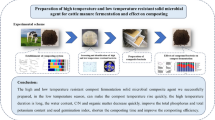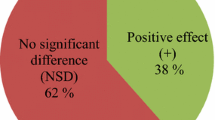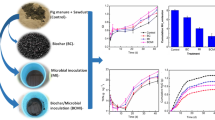Abstract
In this study, fresh cattle manure was mixed with rice straw at a ratio of 10:1 in fresh weight and then composted in a self-built, aerated static composting box, whose dimension was 1 m × 0.8 m × 0.8 m with a volume of approximately 0.6 m3. To deal with the inconvenient and time-consuming problem of multiple stage inoculation, a single, one-time inoculation agent containing diverse microorganisms that are active at both the initial heating and thermophilic phases was developed. A total of 12 from 42 strains isolated from the none-inoculated Experiment 1 composting system were selected as microorganismal agents in Experiment 2 according to their species, prevalence and cultural temperature. 200 mL of each microorganism enrichment broth was mixed to the inoculation group at the beginning of composting. A total of 2400 mL of sterilize distilled water was added to the control group. The parameters of temperature, moisture, pH, C/N ratio, organic matter degradation, and germination index were investigated for both inoculation and control composting groups. Results showed that inoculation did not significantly shorten composting time. However, the pile temperature was increased with the maximum temperatures of 64.6 °C and 60.3 °C for the inoculation and control groups, respectively. The degradation of organic matter was accelerated (P < 0.05), and significantly higher GI value (P < 0.05) indicated that the maturity was promoted by the inoculation microorganism. This suggests that the final composting product would provide value as alternative source of nutrients for plants. Conclusively, we suggested a multiple microorganism inoculation method to increase the efficiency and promote maturity in cattle manure composting.




Similar content being viewed by others
References
Asano R, Otawa K, Ozutsumi Y, Yamamoto N, Abdel-Mohsein HS, Nakai Y (2010) Development and analysis of microbial characteristics of an acidulocomposting system for the treatment of garbage and cattle manure. J Biosci Bioeng 110:419–425
Bernal MP, Paredes C, Sánchez-Monedero MA, Cegarra J (1998) Maturity and stability parameters of composts prepared with a wide range of organic wastes. Bioresour Technol 63:91–99
Bernal MP, Alburquerque JA, Moral R (2009) Composting of animal manures and chemical criteria for compost maturity assessment. A review. Bioresour Technol 100:5444–5453
Bishop PL (1983) Nitrogen transformations during sludge composting. Biocycle 24:34–39
de Bertoldi M, Vallini G, Pera A (1983) The biology of composting: a review. Waste Manage Res 1:157–176
Huang GF, Wong JW, Wu QT, Nagar BB (2004) Effect of C/N on composting of pig manure with sawdust. Waste Manag 24:805–813
Jiang J, Huang Y, Liu X, Huang H (2014) The effects of apple pomace, bentonite and calcium superphosphate on swine manure aerobic composting. Waste Manag 34:1595–1602
Jiang J, Liu X, Huang Y, Huang H (2015) Inoculation with nitrogen turnover bacterial agent appropriately increasing nitrogen and promoting maturity in pig manure composting. Waste Manag 39:78–85
Larney FJ, Hao X (2007) A review of composting as a management alternative for beef cattle feedlot manure in southern Alberta, Canada. Bioresour Technol 98:3221–3227
Li R, Wang JJ, Zhang Z, Shen F, Zhang G, Qin R, Li X, Xiao R (2012) Nutrient transformations during composting of pig manure with bentonite. Bioresour Technol 121:362–368
Matner RR, Fox TL, Mciver DE, Curiale MS (1990) Efficacy of Petrifilm E. coli count plates for E. coli and coliform enumeration. J Food Protect 53:145–150
Miller FC (1992) Composting as a process based on the control of ecologically selective factors. In: Metting FB (ed) Soil microbial ecology. Marcel-Dekker, New York
Ministry of Agriculture of the People’s Republic of China (2012) People's Republic of China agricultural standard: guidelines for organic fertilizer (NY525-2012). Ministry of Agriculture of the People’s Republic of China, Beijing
Muyzer G, Waal ECD, Uitterlinden GA (1993) Profiling of complex microbial populations by denaturing gradient gel electrophoresis analysis of polymerase chain reaction-amplified genes coding for 16s rRNA. Appl Environ Microbiol 59:695–700
Nakasaki K, Araya S, Mimoto H (2013) Inoculation of Pichia kudriavzevii RB1 degrades the organic acids present in raw compost material and accelerates composting. Bioresour Technol 144:521–528
National Bureau of Statistics of China (2016) China statistical yearbook. China Statistics Press, Beijing
Polz MF, Cavanaugh CM (1998) Bias in template-to-product ratios in multitemplate PCR. Appl Environ Microbiol 64:3724–3730
Standardization Administration of the People’s Republic of China (2012) Hygienic requirements for harmless disposal of night soil (GB 7959–2012). Standardization Administration of the People’s Republic of China, Beijing
Sun J, Qian X, Gu J, Wang X, Gao H (2016) Effects of oxytetracycline on the abundance and community structure of nitrogen-fixing bacteria during cattle manure composting. Bioresour Technol 216:801–807
Tan B, Yin Y (2016) Environmental sustainability analysis and nutritional strategies of animal production in China. Annu Rev Anim Biosci 5:171–184
Tiquia SM, Tam NFY (1998) Elimination of phytotoxicity during co-composting of spent pig-manure sawdust litter and pig sludge. Bioresour Technol 65:43–49
Wang HY, Fan BQ, Hu QX, Yin ZW (2011) Effect of inoculation with Penicillium expansum on the microbial community and maturity of compost. Bioresour Technol 102:11189–11193
Xi B, Zhang G, Liu H (2005) Process kinetics of inoculation composting of municipal solid waste. J Hazard Mater 124:165–172
Xi BD, Huang GH, Zhang GJ, Wei ZM, Qin XS, Liu HL (2007) A Temperature-guided three-stage inoculation method for municipal solid wastes composting. Environ Eng Sci 24:745–754
Xi BD, He XS, Wei ZM, Jiang YH, Li MX, Li D, Li Y, Dang QL (2012) Effect of inoculation methods on the composting efficiency of municipal solid wastes. Chemosphere 88:744–750
Xi B, He X, Dang Q, Yang T, Li M, Wang X, Li D, Tang J (2015) Effect of multi-stage inoculation on the bacterial and fungal community structure during organic municipal solid wastes composting. Bioresour Technol 196:399–405
Xu S, Sura S, Zaheer R, Wang G, Smith A, Cook S, Olson AF, Cessna AJ, Larney FJ, McAllister TA (2016) Dissipation of antimicrobial resistance determinants in composted and stockpiled beef cattle manure. J Environ Qual 45:528–536
Zhang J, Zeng G, Chen Y, Yu M, Huang H, Fan C, Zhu Y, Li H, Liu Z, Chen M (2013) Impact of Phanerochaete chrysosporium inoculation on indigenous bacterial communities during agricultural waste composting. Appl Microbiol Biotechnol 97:3159–3169
Zhao Y, Lu Q, Wei Y, Cui H, Zhang X, Wang X, Shan S, Wei Z (2016) Effect of actinobacteria agent inoculation methods on cellulose degradation during composting based on redundancy analysis. Bioresour Technol 219:196–203
Zhou C, Liu Z, Huang ZL, Dong M, Yu XL, Ning P (2015) A new strategy for co-composting dairy manure with rice straw: addition of different inocula at three stages of composting. Waste Manag 40:38–43
Zorpas AA, Loizidou M (2008) Sawdust and natural zeolite as a bulking agent for improving quality of a composting product from anaerobically stabilized sewage sludge. Bioresour Technol 99:7545–7552
Zucconi F, Pera A, Forte M, de Bertoldi M (1981) Evaluating toxicity of immature compost. Biocycle 22:54–57
Acknowledgements
This work was supported by the Science and Technology Tackling and Achievement Conversion Project of Corp (2016AD025), China Postdoctoral Research Foundation (2017M623286) and the National Key Technologies Research and Development Program of China (2016YFD0501406).
Author information
Authors and Affiliations
Contributions
JL, XW, CC and LW did the experiments. FH and YW helped in the data analysis. YX and XL gave many constructive suggestions. LW, the corresponding author, designed this study.
Corresponding author
Ethics declarations
Conflict of interest
The authors declare that they have no conflict of interest.
Ethical statements
This article does not contain any studies with human participants or animals performed by any of the authors.
Rights and permissions
About this article
Cite this article
Li, J., Wang, X., Cong, C. et al. Inoculation of cattle manure with microbial agents increases efficiency and promotes maturity in composting. 3 Biotech 10, 128 (2020). https://doi.org/10.1007/s13205-020-2127-4
Received:
Accepted:
Published:
DOI: https://doi.org/10.1007/s13205-020-2127-4




